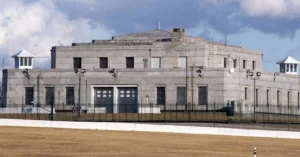What Exactly is Inside Fort Knox?
The gold depository at Fort Knox is one of the most secure and secret places in America. Located in a heavily fortified compound in Kentucky, the facility is overseen by the United States Mint and is responsible for storing a large portion of the country’s gold reserves. Access to the gold vault is tightly controlled, and only a handful of people have ever been allowed inside. As a result, the depository has become a subject of fascination and speculation. Some believe that the gold vault is impenetrable, while others believe that it contains even more gold than is publicly known. Regardless of what secrets may be hidden inside, one thing is certain: the Fort Knox gold vault is one of the most intriguing places in America.
It Holds Tons of Gold – Literally
Fort Knox is perhaps best known as the home of a massive gold reserve. As of 2019, the vault contains 147.3 million ounces of gold, with a book value of $6.22 billion. However, this figure does not take into account the current market value of gold, which would put the reserves at over $273 billion. The gold is stored in the form of 27-pound bars and coins. Although it is no longer used to back currency (the dollar was taken off the gold standard in 1971), it remains a valuable asset.
Outsiders Rarely Get Inside
In 2017, then-Treasury Secretary Steve Mnuchin led a visit by a select few outsiders to take a peek at the gold reserves inside the Fort Knox vault. He was accompanied by Senate Majority Leader Mitch McConnell, and the two of them were photographed holding gold bars. Afterward, in response to concerned citizens voicing their theories online, Mnuchin had an answer: “Glad gold is safe!” he tweeted. The last time Fort Knox had opened its vault to civilians was more than 40 years earlier; however, in 1974, a congressional delegation and some journalists got a look at the gold.
The Building is Impenetrable
Fort Knox is one of the most secure buildings in the world. Constructed in the 1930s, it is designed to withstand any kind of attack. The walls are made of reinforced concrete, and the roof is bomb-proof. The main vault door weighs 20 tons and is 21 inches thick. It is resistant to torches, drills and explosives.

The door is set in position by a time lock that cannot be bypassed. Not one person knows the full combination to the lock. Even if an intruder were able to reach the building, they would not be able to get inside. Fort Knox is impregnable.
Guards and More Guards
Fort Knox is guarded by members of the U.S. Mint Police, one of the oldest federal law enforcement agencies. It was established in 1792. The officers undergo 12 weeks of basic training, followed by five weeks of field training. They learn a long list of heavy-duty skills, including weapons handling, cornering, door entry and room clearing. If that doesn’t seem intimidating enough, Fort Knox sits at the center of a 109,000-acre U.S. Army post and is a training ground for military troops from around the country.
A Frail Foreign Visitor
Occasionally, the vault at Fort Knox has held other precious items, besides gold. In 1939, one of the original copies of the Magna Carta — the Medieval English charter laying down basic human rights — was brought to the U.S. to go on exhibit at the New York World’s Fair.
When World War II erupted, the delicate document was transferred to Fort Knox for safekeeping. The Magna Carta stayed in residence until 1947, when it went back to England. But for a time, it had some treasured American roommates.
America’s Medicine Bunker
In 1955, the US government took an interesting step to ensure the nation had adequate supplies of opium in case of war or supply disruptions: they placed 68,269 pounds of it in the gold depository. This would have been enough to meet the needs of the entire nation for one year. However, as the cold war ended and concerns about supply disruptions abated, the remaining opium reserves were converted into morphine sulfate in 1993. Morphine has a longer shelf life than opium, extending the life of the stock. This decision was made in order to ensure that the nation would have adequate supplies of this vital medication in case of future need.

 with 700+ reviews
with 700+ reviews



